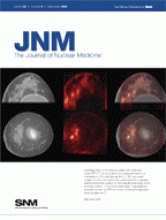REPLY: We appreciate the important comments from Drs. Rudd, Elkhawad, and Fayad regarding our recent investigation of the optimum circulation time for 18F-FDG in relation to atherosclerosis imaging (1), and we would like to address these.
The patients were part of a larger study investigating the role of inflammation in the rate of expansion of abdominal aortic aneurysm. Abdominal aortic aneurysms typically arise in the setting of severe atherosclerosis (2), and several studies have suggested that aneurysmal disease may progress from occlusive disease (3). Inflammation does play an important role in the pathogenesis of atherosclerotic aneurysms, with increased 18F-FDG uptake in symptomatic aneurysms being shown to correlate with macrophage and T-cell infiltrates into the aortic wall (4). This correlation would seem to suggest that the results are applicable to vascular inflammation imaging in other arterial territories.
We accept that the use of unenhanced CT made identification of the aortic lumen more difficult for region-of-interest placement, but we suggest that the wall is easy to identify because it is peripherally bound by intraabdominal fat, which has a different CT density. One advantage of using the aorta, instead of the carotid or iliac arteries, is that it is larger and thus has more easily identified boundaries.
The outcome variable was the maximum standardized uptake value at the area of most intense aortic wall 18F-FDG uptake averaged over each dynamic acquisition at each time point. This value was identified by examining each PET/CT slice acquired. However, only a single bed position covering the abdominal aorta was acquired. Therefore, no other vascular territories were examined.
We chose the lumen of the aorta as the background region of interest because the diameter of the lumen of an aortic aneurysm is considerably larger than that of the adjacent inferior vena cava. Therefore, we aimed to minimize spillover from one region into another by selecting a centrally placed region of interest at the center of the enlarged lumen. The effect of any remaining spillover would be to reduce the target-to-background ratio and therefore minimize any changes with time. We agree that partial-volume errors are an important consideration in the semiquantitative analysis of 18F-FDG uptake when the structures of interest (e.g., blood vessels) are smaller than the spatial resolution of the imaging system. We also agree that such errors may contribute to the variability of findings.
Footnotes
-
COPYRIGHT © 2009 by the Society of Nuclear Medicine, Inc.







